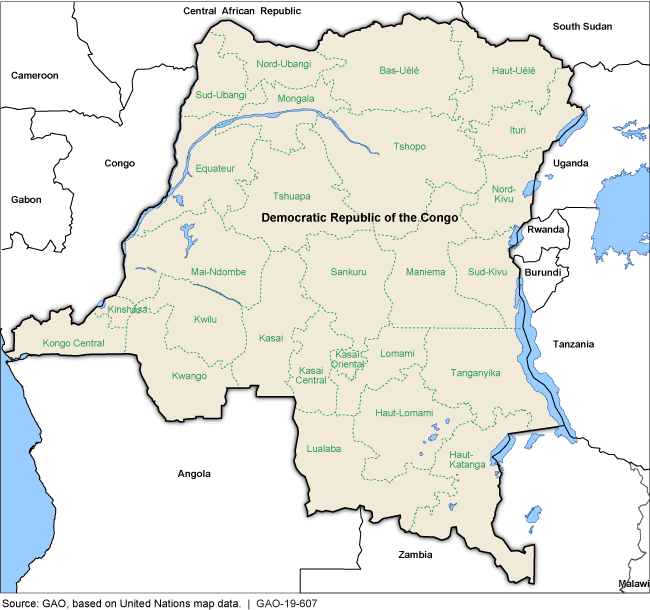Conflict Minerals: 2018 Company Reports on Mineral Sources Were Similar in Number and Content to Those Filed in the Prior 2 Years
Fast Facts
In the Democratic Republic of the Congo and adjoining countries, armed groups have committed severe human rights abuses and reportedly profit from the exploitation of conflict minerals—namely, gold, tantalum, tin, and tungsten.
In 2012, the Securities and Exchange Commission began to require certain companies to disclose their use of conflict minerals sourced from this region.
We found that, of 1,117 companies filing conflict minerals disclosures in 2018, an estimated 56% of them were able to determine whether the conflict minerals in their products came from this region—about the same as in 2017 and 2016.
The Democratic Republic of the Congo, Its Provinces, and Adjoining Countries

Map of the Democratic Republic of the Congo
Highlights
What GAO Found
Companies' conflict minerals disclosures filed with the U.S. Securities and Exchange Commission (SEC) in 2018 were, in general, similar in number and content to disclosures filed in the prior 2 years. In 2018, 1,117 companies filed conflict minerals disclosures—about the same number as in 2017 and 2016. The percentage of companies that reported on their efforts to determine the source of minerals in their products through supply chain data collection (country-of-origin inquiries) was also similar to percentages in those 2 prior years. As a result of the inquiries they conducted, an estimated 56 percent of the companies reported whether the conflict minerals in their products came from the Democratic Republic of the Congo (DRC) or any of the countries adjoining it—similar to the estimated 53 and 49 percent in the prior 2 years. The percentage of companies able to make such a determination significantly increased between 2014 and 2015, and has since leveled off, as shown below.
Source of Conflict Minerals in Products as Determined by Companies' Reasonable Country-of-Origin Inquiries, Reporting Years 2014-2018

Note: “Covered countries” include the Democratic Republic of the Congo and the adjoining countries.
In their 2018 disclosures, some companies reported taking the same actions to improve supply chain data collection that they had taken in past years, and many noted difficulties in determining conflict minerals' country of origin. A subset of the companies in the figure had not determined their minerals' origin or had reason to believe their minerals were from covered countries (and not from scrap or recycled sources) and were, as a result of the inquiry, required to conduct additional research (due diligence). Of those that conducted due diligence, an estimated 61 percent reported they were unable to confirm the source of minerals in their products. An estimated 35 percent reported using conflict minerals from covered countries or from scrap or recycled sources. Although some companies noted that guidance the SEC staff revised in 2017 had caused uncertainty about the filing process, most filings were similar to those submitted in prior years.
GAO found no new population-based surveys on the rate of sexual violence in eastern DRC and three countries adjoining that region—Burundi, Uganda, and Rwanda—but found other types of information on sexual violence.
Why GAO Did This Study
Since the UN first deployed a peacekeeping mission to the DRC 2 decades ago, the United States and the international community have sought to improve security in the country. In eastern DRC, armed groups have committed severe human rights abuses, including sexual violence, and reportedly profit from the exploitation of “conflict minerals”—in particular, tin, tungsten, tantalum, and gold—according to the UN. Congress included a provision in the 2010 Dodd-Frank Wall Street Reform and Consumer Protection Act that, among other things, required the SEC to promulgate regulations regarding the use of conflict minerals from the DRC and adjoining countries. The SEC adopted these regulations in 2012. The act also included a provision for GAO to annually assess the SEC regulations' effectiveness in promoting peace and security and to report on the rate of sexual violence in the DRC and adjoining countries.
In this report, GAO (1) examines how companies responded to the SEC conflict minerals disclosure rule when filing in 2018 and (2) provides recent information on the rate of sexual violence in eastern DRC and adjoining countries. GAO analyzed a generalizable random sample of SEC filings and interviewed relevant officials. GAO also reviewed U.S. government, UN, and international organization reports; interviewed DRC officials and other stakeholders; and conducted fieldwork in California at an industry conference.
For more information, contact Kimberly M. Gianopoulos at (202) 512-8612 or gianopoulosk@gao.gov.
